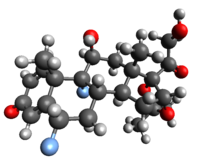Fluocinolone acetonide
 | |
 | |
| Clinical data | |
|---|---|
| Trade names | Synalar, Iluvien, others |
| AHFS/Drugs.com | Monograph Monograph |
| Pregnancy category |
|
| Routes of administration | Topical, ophthalmic intravitreal injection |
| ATC code | |
| Legal status | |
| Legal status |
|
| Pharmacokinetic data | |
| Metabolism | Liver, CYP3A4-mediated |
| Elimination half-life | 1.3 to 1.7 hours |
| Identifiers | |
| CAS Number | |
| PubChem CID | |
| IUPHAR/BPS | |
| DrugBank | |
| ChemSpider | |
| UNII | |
| KEGG | |
| ChEBI | |
| ChEMBL | |
| CompTox Dashboard (EPA) | |
| ECHA InfoCard | 100.000.607 |
| Chemical and physical data | |
| Formula | C24H30F2O6 |
| Molar mass | 452.495 g·mol−1 |
| 3D model (JSmol) | |
show
InChI | |
| | |
Fluocinolone acetonide is a corticosteroid primarily used in dermatology to reduce skin inflammation and relieve itching.[citation needed] It is a synthetic hydrocortisone derivative. The fluorine substitution at position 9 in the steroid nucleus greatly enhances its activity. It was first synthesized in 1959 in the Research Department of Syntex Laboratories S.A. Mexico City.[1] Preparations containing it were first marketed under the name Synalar. A typical dosage strength used in dermatology is 0.01–0.025%. One such cream is sold under the brand name Flucort-N and includes the antibiotic neomycin.
Fluocinolone acetonide was also found to strongly potentiate TGF-β-associated chondrogenesis of bone marrow mesenchymal stem/progenitor cells, by increasing the levels of collagen type II by more than 100 fold compared to the widely used dexamethasone.[2]
Fluocinolone acetonide intravitreal implants have been used to treat non-infectious uveitis. A systematic review could not determine whether fluocinolone acetonide implants are superior to standard of care treatment for uveitis.[3] A fluocinolone acetonide intravitreal implant with the brand name Iluvien is sold by biopharmaceutical company Alimera Sciences to treat diabetic macular edema (DME).[4]
It was approved for medical use in 1961.[5]
Classification[]
Fluocinolone is a group V (0.025%) or group VI (0.01%) corticosteroid under US classification.
See also[]
- Topical steroid
- Fluocinonide
- Ciprocinonide
- Glucocorticoid
References[]
- ^ J S Mills, A. Bowers, Carl Djerassi and H.J. Ringold, Steroids CXXXVII. Synthesis of a New Class of Potent Cortical Hormones. 6α,9α-Difluoro-16α-Hydroxyprednisolone and its Acetonide, Journal of the American Chemical Society, 80, 3399-3404 (1960)
- ^ Hara ES, Ono M, Pham HT, Sonoyama W, Kubota S, Takigawa M, Matsumoto T, Young MF, Olsen BR, Kuboki T. Fluocinolone Acetonide is a Potent Synergistic Factor of TGF-β3-Associated Chondrogenesis of Bone Marrow-Derived Mesenchymal Stem Cells for Articular Surface Regeneration. J Bone Miner Res. 2015. http://onlinelibrary.wiley.com/doi/10.1002/jbmr.2502/abstract
- ^ Brady CJ, Villanti AC, Law HA, Rahimy E, Reddy R, Sieving PC, Garg SJ, Tang J (2016). "Corticosteroid implants for chronic non-infectious uveitis". Cochrane Database Syst Rev. 2: CD010469. doi:10.1002/14651858.CD010469.pub2. PMC 5038923. PMID 26866343.
- ^ "Real-world study shows long-term safety, efficacy of Iluvien in DME". Healio. 2020-07-02. Retrieved 2020-10-28.
- ^ Fischer, Jnos; Ganellin, C. Robin (2006). Analogue-based Drug Discovery. John Wiley & Sons. p. 485. ISBN 9783527607495.
External links[]
- "Fluocinolone acetonide". Drug Information Portal. U.S. National Library of Medicine.
- Acetonides
- Corticosteroid cyclic ketals
- Corticosteroids
- Diketones
- Diols
- Fluoroarenes
- Glucocorticoids
- Otologicals
- Cardiovascular system drug stubs
- Dermatologic drug stubs
- Ophthalmology stubs